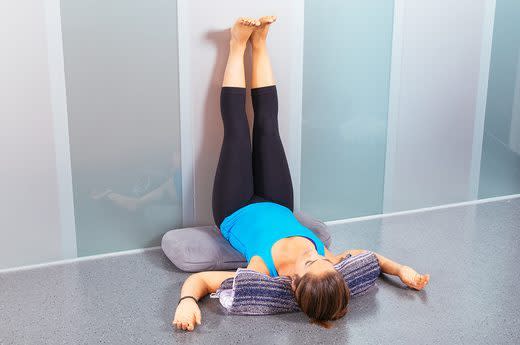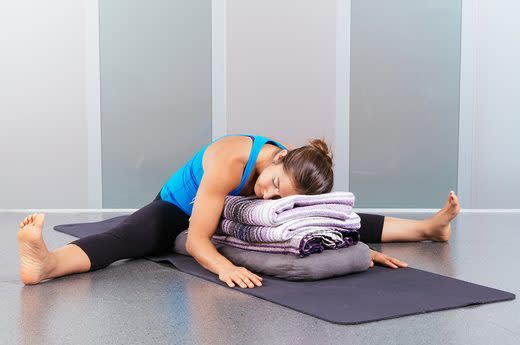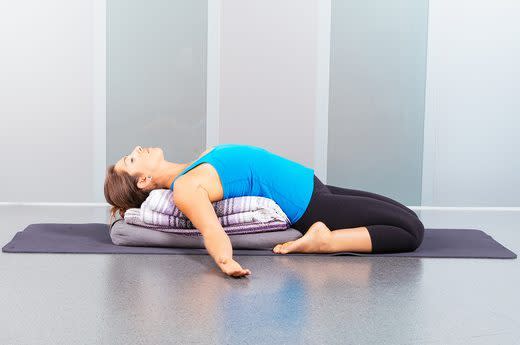6 Yoga Poses to Help You Recover From Your Workout

Yoga can reduce stress levels. (Photos: Kelsey Tucker/DescribeTheFauna.com)
Restorative yoga uses props to ensure that the body is able to deeply relax. Props, gravity and breathing do the work for you; there’s no trying or forcing. It’s an energizing shift from how today’s world operates – and everyone, especially athletes, needs balance. “Athletes who are coming to practice realize the value of resting the body as an important component of their training regimen,” says Lauren Eckstrom, an experienced restorative yoga teacher in Venice, California. “What keeps them coming back is how good they feel. They become more attuned to their bodies. They’re sleeping soundly, there are improvements in digestion, insomnia, athletic performance.”
Practicing restorative poses at least once a week is a proactive step in preventing overuse injuries, burnout and fatigue. Here are six poses for you to try. Before you begin, you’ll need one bolster, at least two blankets and two blocks for these moves.
1. Supported Bridge Pose (Setu Bandha Sarvangasana)
For many athletes, one of the most chronic points of tension is the hip flexor. The hips flexors become tight due to movements like squatting, running and biking, not to mention daily tasks like sitting and driving. When the hip flexors become shortened, a chain of events occurs: The pelvis rotates forward, which elongates the hamstrings and gluteus maximus beyond their ideal length. This makes the hamstrings and glutes weak. A weak muscle cannot contract with proper force since the neuromuscular system is confused and cannot recruit the ideal muscle fibers to fire. Release the tension and restore your body back to a more balanced state with this pose.
Related: How to Create Your Own Yoga Routine
HOW TO DO IT: Lie on your back, bend your knees, press your feet into the floor and engage your glutes to lift your hips. Place a block under the bony back part of your pelvis. The block can run vertically or horizontally, depending on your comfort. You also have the option to place a strap around your thighs. Relax on top of the block with arms at your sides and breathe down the front of your body into your hip flexors for two to five minutes.

2. Reclining Bound Angle Pose (Supta Baddha Konasana)
Sinking into this pose is like taking a mini vacation. The external rotation of the hips and support of the upper back to help open the chest and externally rotate the shoulders compensate for the tasks we do each day like driving and sitting at a computer desk. Supporting the knees with blocks allow the inner thighs to open and receive a loving stretch without adding any strain or discomfort.
HOW TO DO IT: Lie back on a bolster with your spine supported, sit bones on the floor and a blanket under your head for support. Bring the soles of your feet together and place a block under each knee for support. Relax your arms out the sides and melt into this pose for five to 10 minutes.

3. Legs-Up-the-Wall Pose (Viparita Karani)
This pose literally means “reverse action.” It helps drain the lymphatic system to carry toxins to the liver and kidneys for excretion, reverses blood flow and can mentally help flip your perspective of stressful issues. “The feet are such selfless servants,” says yoga teacher Lauren Eckstrom. “It’s nurturing to give them a break while still feeling grounded.”
HOW TO DO IT: Place a bolster or blanket under your hips for support. Take a seat with your sit bones as close to the wall as comfortable, lie back with your arms relaxed and out to the side and send your legs straight up the wall. The more flexible you are through your lower body, the more comfortable you’ll feel closer to the wall. If you’d like, you can place a strap around your thighs for more support. Breathe and let go as you relax for five to 10 minutes in this pose.

4. Supported Wide-Angle Seated Forward Fold (Upavistha Konasana)
This stretch relieves tension in the low back and lengthens the hamstrings. An added bonus is the deep inner-thigh stretch. Opening up these centers of the body may help alleviate low-back or abdominal pain as well as feelings of irritation or anger. Relax deeply into the pose and see if you feel a shift in your mood.
Related: The Only 5 Exercises Women Need to Get Lean
HOW TO DO IT: Sit on the mat with your legs spread wide (about 90 degrees, depending on your flexibility). You can sit on a folded blanket under your sit bones to support your lower back if necessary. Place a bolster in front of you with blankets on top to adjust to your level of flexibility. Hinge forward at the hips. You can cross your arms and place them on the cushion in front of you, resting your forehead on top or relaxing your chest onto the bolster and turning your head to one side. Stay here for five to 10 minutes.

5. Reclining Hero Pose (Supta Virasana)
Reclining hero pose is an excellent pose to open up the chest, shoulders and upper back and lengthen the abdomen, hip flexors and quadriceps. Be mindful, though: The reclining version in particular can be too advanced if you have any knee issues.
HOW TO DO IT: Place your bolster on your mat. Come to a kneeling position in front of your bolster with your shins hugged in close to the midline of your body, buttocks completely on the floor and ankles in a neutral position. The edge of the bolster should align with the base of your pelvis. Lower your back toward the bolster, placing your elbows on the floor and lying back. Draw your front ribs in, lift your pubis toward your navel to create length in your low back and breathe into your low back as you sink deeply into the pose for two to five minutes.

6. Supported Child’s Pose (Salamba Balasana)
Child’s pose eases the nervous system, allows you to relax the front side of the body, breathe into the back body and rest your head, delivering a sense of calm. HOW TO DO IT: Place your bolster on your yoga mat. Fold blankets so they are eight to 12 inches in width and stack on top of the bolster if needed. Place your knees to the sides of the bolster. If your knees or hips are tender, you can place a blanket over your shins and under your hips for added support. Sit your hips back toward your heels. Lengthen the sternum and fold forward over the bolsters, placing your arms at the sides and resting your cheek on the bolster. Breathe into your back body and relax deeply for as long as you’d like.
The original article “10 Yoga Poses to Help You Recover From Your Workout“ appeared on LIVESTRONG.COM.
By Kelly Gonzalez
More from LIVESTRONG.COM:
The Best 8 Stretches to Beat Back Pain
13 Yoga Poses to Help You Be Less of a Klutz
The “Hurt So Good” Workout

